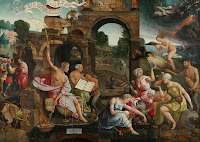Luis Ricardo Faléro, Departure of the Witches, 1878, oil on canvas, 145.5 x 118.2 cm.
Luis Faléro is interesting on his own. Born in Spain in 1851, he was a precocious child. He studied in London when he was young and eventually settled there in 1887. But first, he ran away from a career in the Spanish Navy when he was only 16 years old. On foot. To Paris. Paying his way by doing crayon portraits. In Paris, he studied chemistry, engineering, and art, but abandoned the first two because they were too dangerous. Oh, and he also took up astronomy.
Some sources say Faléro was the Duke of Labranzano, but in any case, he was rich. With a pointed beard and black hair, he looked like he stepped out of a Velázquez painting. His compatriots called him Don Luis. In 1896, Maud Harvey sued him for paternity. She claimed that he seduced her when she was his 17-year-old housemaid and artist’s model. He fired her after he discovered she was pregnant. Although she was awarded 5 shillings per week, the suit may not have done her much good. Faléro died in December that same year.
In reality, I don’t like much of Faléro’s art. He specialized in female nudes in allegorical settings. And while many of them are interesting as precursors to the work of art nouveau artist Alfons Mucha, they’re all incredibly syrupy. Like soft-focus Barbie dolls with no naughty-bits. He’s basically a more ethereal Bouguereau.
Right: William-Adolphe Bouguereau, Night, 1883, oil on canvas, 208.3 x 107.4 cm
Center: Luis Ricardo Faléro, Twin Stars, 1881, watercolor on paper, 41.9 x 21.6 cm.
Left: Alfons Mucha, Study for The Morning Star, 1902, ink and watercolor on paper, 56 x 21 cm.
But Departure of the Witches is different. It still has a pin-up girl aesthetic, but it also has grit, energy, and a little humor (did you see the skeleton’s mustache?!). And while the pattern-like groups of activity remind me of Dutch and Flemish art, Departure looks like it could have been painted yesterday. You know, by someone who really likes late 19th century academic art.
Right: Gil Elvgren, Riding High, 1958, oil on canvas, 76.2 x 61 cm.
Left: Jacob Cornelisz van Oostsanen, Saul and the Witch of Endor, 1526, oil on panel, 85.5 x 122.8cm.
In reality, Departure of the Witches probably depicts a scene from the German legend of Faust in which a successful scholar makes a pact with the devil in exchange for unlimited knowledge and worldly pleasure. Johann Wolfgang von Goethe’s version of the legend was popular in theatres of the time, and Faléro is known to have painted at least one other depiction of the story. In fact, Sotheby’s mistakenly titled the painting Faust’s Vision in a 2003 auction and said that it had been exhibited in the Paris Salon of 1880. Oddly enough, the real Faust’s Vision was in the same auction mistakenly titled Faléro’s Dream.
Luis Ricardo Faléro, Faust’s Vision, 1880, oil on canvas, 81.2 x 150.5 cm.
Anyway, in Goethe’s play, the demon Mephistopheles represents the devil and leads Faust on a quest for ultimate bliss. With his help, Faust seduces Gretchen, a girl who becomes pregnant with his illegitimate child. To distract Faust from his situation, Mephistopheles gives him a dream of Walpurgis Night, a spring festival exactly 6 months before All Hallows' Eve when witches gather for their annual Sabbath in the German mountains. The dream lasts months, and Faust wakes to find that Gretchen has given birth, drowned the baby, and is sentenced to death.
So there you have it. Departure of the Witches depicts a fever dream of hellish debauchery. Maybe the lone man in the painting is Faust. Or maybe the painting hints at Faléro’s own scandalous future. Maybe the man is the artist himself.





